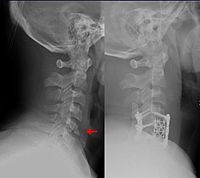
Photo from wikipedia
Supplemental Digital Content is Available in the Text. Objective: To examine the effects of implementing a dedicated orthopaedic trauma room (DOTR) on hip and femur fracture care. Design: A retrospective… Click to show full abstract
Supplemental Digital Content is Available in the Text. Objective: To examine the effects of implementing a dedicated orthopaedic trauma room (DOTR) on hip and femur fracture care. Design: A retrospective cohort study. Setting: Level 1 trauma center. Patients: 2928 patients with femoral neck, pertrochanteric, and femoral shaft and distal femur (FSDF) fractures. Intervention: Implementation of a DOTR. Main Outcome Measures: Hospital length of stay (LOS), emergency department (ED) LOS, intensive care unit (ICU) LOS, and time to operating room (TTOR). Results: Implementation of a DOTR resulted in significant improvement in TTOR for all patient groups (P < 0.05). We found shorter TTOR for pertrochanteric (P < 0.001), femoral neck (P = 0.039), and FSDF groups (P = 0.046). Total hospital LOS was shorter for patients with pertrochanteric (P < 0.001) and femoral neck fractures (P = 0.044). Patients with pertrochanteric hip fractures demonstrated shorter ICU LOS (P < 0.001). No LOS improvements were observed among patients in the FSDF group. ED LOS was significantly longer in all patient groups (P < 0.001). Conclusions: Implementation of a DOTR was associated with shorter TTOR, shorter hospital and ICU LOS, and longer ED LOS. There was a greater number of patients transferred into the investigating institution and fewer patients transferred out. These data support the utility of a DOTR as it relates to an improvement in hospital stay–related outcomes in patients with fractures of the hip and femur. Our results suggest that a DOTR in a Level I trauma hospital is associated with improvement in patient care. Level of Evidence: Therapeutic Level III. See Instructions for Authors for a complete description of levels of evidence.
Journal Title: Journal of Orthopaedic Trauma
Year Published: 2022
Link to full text (if available)
Share on Social Media: Sign Up to like & get
recommendations!